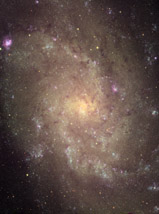| OIR Research: M33 | ||||
|
Messier 33, also known as the Pinwheel or Triangulum Galaxy, is the third-largest galaxy in the Local Group, after Messier 31 and the Milky Way. It provides a unique laboratory for the study of star formation. Nearly all the star formation in the modern Universe occurs in large, cold clouds of molecular hydrogen known as Giant Molecular Clouds (GMCs). Typical GMCs are nearly a million times as massive as the sun and are frequently seen to be the formation site of large stellar clusters and high mass stars. The intense winds and radiation from newly-formed high mass stars ultimately destroys the parent GMC, returning the clouds material to the diffuse interstellar medium. Using the 45-meter radio telescope in Nobeyama, Japan in conjunction with the BIMA millimeter interferometer in Hat Creek, California, scientists at the CfA have studied GMCs in Messier 33. This study has revealed how the ongoing star formation changes the galactic environment. In addition, the study also demonstrates that the different parts of the galaxy have different types of molecular clouds. This variation will control the numbers and types of stars and star clusters formed in the galaxy. In turn, the differences in the newly formed stars will be ultimately responsible for a galaxy's evolution over its lifetime.
Scientific Publications
People |
 The Giant Molecular Clouds (GMCs) in M33 are shown as blue dots with the size of the dot representing the mass of the molecular cloud. The background (red) emission traces gas ionized by young, massive stars that were formed in GMCs and is therefore the hallmark of recent star formation. GMCs are often seen associated with young, massive stars in the center of M33, but there are fewer GMCs in the outer portions of the galaxy. Photo Credit: CO (Rosolowsky et al. 2007), Ha (Massey et al. 2006) Press release ... | |||




